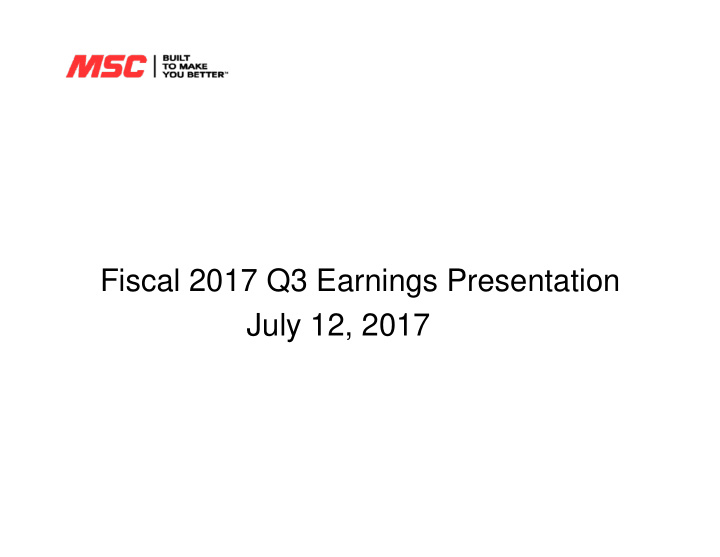



Fiscal 2017 Q3 Earnings Presentation July 12, 2017
Risks and Non-GAAP Disclosures This presentation contains forward-looking statements within the meaning of U.S. securities laws, including guidance about expected future results, expectations regarding our ability to gain market share, expected benefits from our investment and strategic plans, and expected future margins. These forward-looking statements involve risks and uncertainties that could cause actual results to differ materially from those anticipated by these forward-looking statements; are based on our current expectations; and we assume no obligation to update them. Factors that could cause actual results to differ materially from those in forward-looking statements include: general economic conditions in the markets in which we operate, worldwide economic, social, political and regulatory conditions, including conditions that may result from legislative, regulatory and policy changes, changing customer and product mixes, competition, including the adoption by competitors of aggressive pricing strategies and sales methods, industry consolidation, volatility in commodity and energy prices, credit risk of our customers, risk of cancellation or rescheduling of orders, work stoppages or other business interruptions (including those due to extreme weather conditions) at transportation centers or shipping ports, financial restrictions on outstanding borrowings, dependence on our information systems and the risk of business disruptions arising from changes to our information systems, disruptions due to computer system or network failures, computer viruses, physical or electronics break-ins and cyber-attacks, the loss of key suppliers or supply chain disruptions, problems with successfully integrating acquired operations, opening or expanding our customer fulfillment centers exposes us to risks of delays, the risk of war, terrorism and similar hostilities, dependence on key personnel, goodwill and intangible assets recorded as a result of our acquisitions could be impaired, and the outcome of potential government or regulatory proceedings or future litigation relating to pending or future claims, inquiries or audits. Information about these risks is noted in the earnings press release and in the Risk Factors and MD&A sections of our latest annual and quarterly reports filed with the SEC, as well as in our other SEC filings. Investors are cautioned not to place undue reliance on these forward-looking statements. Throughout this presentation we will reference both GAAP and adjusted financial results, which are non-GAAP financial measures. Please refer to the reconciliation tables at the end of this presentation for a reconciliation of the adjusted financial measures to the most directly comparable GAAP measures. | 12 ‐ Jul ‐ 2017 2
FY 2017 Q3 Guidance Comparison FY 2017 Q3 FY 2017 Q3 Guidance Results Net Sales $734M – $748M $743.9M Gross Margin 44.4% - 44.8% 44.3% Operating Expenses $230.5M $227.7M Tax Rate 36.3% 36.3% Diluted EPS $1.05 – $1.09 $1.09 | 12 ‐ Jul ‐ 2017 3
FY 2017 Q4 Guidance Net Sales $732M - $746M Gross Margin 43.8% +/- 20 bps Tax Rate 37.3% Diluted EPS $0.97 - $1.01 | 12 ‐ Jul ‐ 2017 4
FY 2017 Annual Operating Margin Framework MSC Growth Level Slightly Positive Price Environment 12.6% 13.3% (+/- 50 bps) (+/- 50 bps) Slightly Negative 12.2% 12.7% (+/- 50 bps) (+/- 50 bps) Slightly Negative Slightly Positive | 12 ‐ Jul ‐ 2017 5
Reconciliations Non-GAAP Financial Measures Free Cash Flow Our measure of “Free cash flow” meets the definition of a non-GAAP financial measure. Free cash flow is used in addition to and in conjunction with results presented in accordance with GAAP and free cash flow should not be relied upon to the exclusion of GAAP financial measures. Management strongly encourages investors to review our financial statements and publicly-filed reports in their entirety and to not rely on any single financial measure. Free cash flow, which we reconcile to “Net cash provided by operating activities,” is cash flow from operations reduced by “Expenditures for property, plant and equipment”. We believe that free cash flow, although similar to cash flow from operations, is a useful additional measure since capital expenditures are a necessary component of ongoing operations. Management also views free cash flow as a measure of the Company’s ability to reduce debt, add to cash balances, pay dividends, repurchase stock, and fund other financing activities. Free cash flow has limitations due to the fact that it does not represent the residual cash flow available for discretionary expenditures. For example, free cash flow does not incorporate payments made on capital lease obligations or cash payments for business acquisitions. In addition, different companies define free cash flow differently. Therefore, we believe it is important to view free cash flow as a complement to our entire consolidated statements of cash flows. A reconciliation of cash provided by operating activities to free cash flow for the thirteen and thirty-nine weeks ended June 3, 2017 and May 28, 2016 is shown below. Thirteen Weeks Ended June 3, 2017 May 28, 2016 (in millions) (in millions) Net cash provided by operating activities $ 62.5 $ 102.8 Expenditures for property, plant and equipment (12.4) (7.9) Free cash flow $ $ 50.1 94.9 Thirty-Nine Weeks Ended June 3, 2017 May 28, 2016 (in millions) (in millions) Net cash provided by operating activities $ 159.1 $ 285.8 Expenditures for property, plant and equipment (37.9) (34.7) Free cash flow $ $ 121.2 251.1 | 12 ‐ Jul ‐ 2017 6
Recommend
More recommend